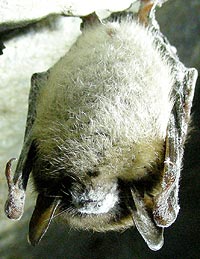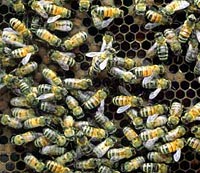自从1958年,奥尔加·欧文·哈金斯(Olga Owen Huckins)与她的朋友雷切尔·卡森(Rachel Carson)分享了一个充满死亡,ddt poison鸟的院子的奇观以来,科学家一直在追踪农药中的野生动植物的巨大危害。如今,到处都是我们周围的农药滴水和泛滥,污染了美国90%的主要河流和溪流,超过80%的采样鱼类,以及该国三分之一的含水层。根据美国鱼类和野生动植物服务局的说法,每年数百万的鱼类和鸟类毫无疑问地暴露于这种化学汤中。
但是,随着监管机构应对农药的致命危险,科学家发现,即使是良性,对农药的低水平暴露也会以微妙的意外方式影响野生生物,甚至可以为新的流行物种推向新的流行病,将其推向新的流行病。灭绝的边缘。
In the past dozen years, no fewer than three never-before-seen diseases have decimated populations of amphibians, bees, and — most recently — bats. A growing body of evidence indicates that pesticide exposure may be playing an important role in the decline of the first two species, and scientists are investigating whether such exposures may be involved in the deaths of more than 1 million bats in the northeastern United States over the past several years.

For decades, toxicologists have accrued a range of evidence showing that low-level pesticide exposure impairs immune function in wildlife, and have correlated this immune damage to outbreaks of disease. Consumption of pesticide-contaminated herring has been found to impair the immune function of captive seals, for example, and may have contributed to an outbreak of distemper that killed over 18,000 harbor seals along the northern European coast in 1988. Exposure to PCBs has been correlated with higher levels of roundworm infection in Arctic seagulls. The popular herbicide atrazine has been shown to make tadpoles more susceptible to parasitic worms.
最近的大量死亡始于两栖动物。科学家发现了罪魁祸首 - 一种称为Batrachochytrium dendrobatidis两栖动物专家凯文·齐佩尔(Kevin Zippel)说,在1998年的一类名为“ Chytrids”的真菌中,它的破坏是“与自恐龙灭绝以来所见过的任何东西。”目前,超过1,800种两栖动物面临灭绝。
It may be, as many experts believe, that the chytrid fungus is a novel pathogen, decimating species that have no armor against it, much as Europe’s smallpox and measles decimated Native Americans in the sixteenth and seventeenth centuries. But “there is a really good plausible story of chemicals affecting the immune system and making animals more susceptible,” as well, says San Francisco State University conservation biologist Carlos Davidson.
上风农药的使用与两栖动物种群下降之间存在很强的相关性。
例如,在加利福尼亚州,已知在圣华金山谷的农作物上涂有杀虫剂会向上驶向内华达山脉,在那里它们沉淀在空中,雪和地表水中以及两栖动物的组织内。当戴维森(Davidson)比较了1971年至1991年的加利福尼亚州的农药使用,栖息地损失,风模式和两栖动物人口的历史报告时,他发现上风农药的使用之间存在很强的相关性 - 尤其是抑制胆碱酯酶的化学物质,例如杀虫剂碳脂化化学物质- 以及两栖动物人群的下降。
实验证据增强了戴维森的发现。在实验室实验中,暴露于碳碳纤维的暴露于黄腿青蛙生产的真菌战斗化合物,称为抗菌肽,这可能对两栖动物的能力至关重要。进一步的测试表明,产生最有效的抗菌肽混合物的两栖动物可抵抗实验性chytrid感染,并且往往是在野外成功生存最多的两种物种。
科学家发现对两栖动物的真菌攻击六年后,一场神秘的瘟疫开始消灭蜜蜂。觅食的蜜蜂开始从蜂箱中消失,于2004年因饥饿而放弃了他们的育雏和皇后。在2006年至2009年之间,殖民地崩溃障碍和其他疾病摧毁了美国蜜蜂人口的35%。
一些专家认为,殖民地崩溃障碍是蜜蜂养育因素的“完美风暴”的结果:营养不良,几十年来工业养蜂实践中的免疫功能障碍以及

opportunism of multiple pathogens, acting in malevolent concert. But many beekeepers believe that a new class of chemicals based on nicotine, called neonicotinoids, may be to blame.
Neonicotinoids came into wide use in the early 2000s. Unlike older pesticides that evaporate or disperse shortly after application, neonicotinoids are systemic poisons. Applied to the soil or doused on seeds, neonicotinoid insecticides incorporate themselves into the plant’s tissues, turning the plant itself into a tiny poison factory emitting toxin from its roots, leaves, stems, pollen, and nectar.
在德国,法国,意大利和斯洛文尼亚,养蜂人对新烟碱对蜜蜂菌落的影响的担忧导致了对化学物质的一系列禁令。In the United States, regulators have approved their use, despite the fact that the Environmental Protection Agency’s standard method of protecting bees from insecticides — by requiring farmers to refrain from applying them during blooming times when bees are most exposed — does little to protect bees from systemic pesticides.
美国农业部(USDA)昆虫学家杰夫·佩蒂斯(Jeff Pettis)说:“这些公司认为这是安全的。”他解释说:“它在较低的水平上使用,是农民的福音。”此外,多年的研究表明,只有非常低的化学物质是从处理的植物的花粉和花蜜中散发出来的。
The bat die-off ‘is the most precipitous wildlife decline in the past century in North America.’
但是帕多亚大学昆虫学家Vincenzo Girolami认为,他可能发现了一种意外的机制,尽管新烟碱的应用方式是新烟碱,但实际上确实杀死了蜜蜂。在春季,使用播种机种植新烟碱涂层的种子,将杀虫剂云塞入空气中。他说:“云宽20米,有时是50米,机器上下上下移动。”“越过田野,每十分钟旅行的蜜蜂有很高的遇到这云的可能性。如果他们每五分钟旅行一次,可以肯定的是他们会遇到这云。”
And the result could be immediately devastating. In as-yet-unpublished research, Girolami has found concentrations of insecticide in clouds above seeding machines 1,000 times the dose lethal to bees. In the spring, when the seed machines are working, says Girolami, “I think that 90 percent or more of deaths of bees is due to direct pesticide poisoning.”
Girolami还发现,在其他意外(通常未经测试的地方)中,新烟碱的水平,例如沿叶缘的液体滴分泌的液体,蜜蜂和其他昆虫都会饮用。(科学界尚未权衡吉罗拉米(Girolami)的新研究,但听说这项工作的佩蒂斯(Pettis)称这是“一个好的,合理的解释。”)
Two years after the honeybees started disappearing, so, too, did bats. The corpses of hibernating bats were first found blanketing caves in the northeastern United States in 2006. The disease that killed them, caused by a cold-loving fungus calledGeomyces Destructans— and dubbed White-nose Syndrome for the tell-tale white fuzz it leaves on bats’ ears and noses — has since destroyed at least one million bats. University of Florida wildlife ecologist John Hayes calls it “the most precipitous wildlife decline in the past century in North America.”
像神秘的Batrachochytrium dendrobatidisfungus infesting amphibians,Geomyces可能是一种新颖的病原体,新捕食无防御能力的蝙蝠物种。但是,科学家还开始研究农药暴露是否可能发挥作用。
蝙蝠特别容易受到化学污染的影响。它们很小 - 棕色小蝙蝠的重量仅为8克 - 并且可以持续三十年。波士顿大学蝙蝠研究员和博士学位指出:“这是积累农药和污染物的时间。”候选人玛丽安·摩尔(Marianne Moore)正在研究环境污染物是否抑制蝙蝠的免疫功能。她说:“我们知道它们会暴露于有机氯,汞,砷,铅,二恶英,但我们不了解这种影响。”
Which, in the end, is the central dilemma facing pesticide-reliant societies. Proving, with statistical certainty, that low-level pesticide exposure makes living things more vulnerable to disease is notoriously difficult. There are too many different pesticides, lurking in too many complex, poorly understood habitats to build definitively damning indictments. The evidence is subtle, suggestive. But with the rapid decimation of amphibians, bees, and bats, it is accumulating, fast.